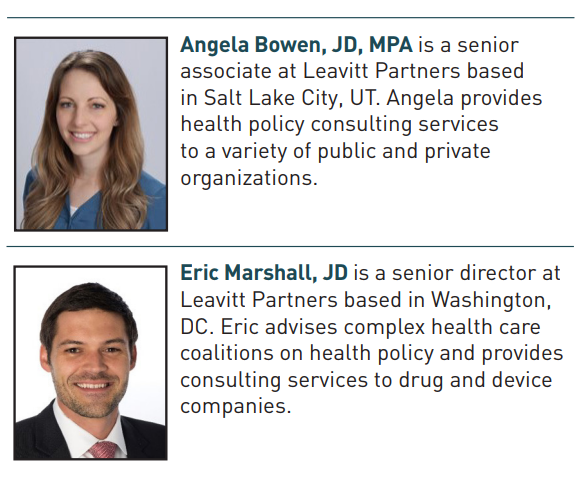
FDA’s New Pilot Program Encouraging Innovation
by Angela Bowen and Eric Marshall 
On August 29, 2018, the Food and Drug Administration (FDA) announced the Complex Innovative Trial Designs (CID) Pilot Meeting Program (the pilot).1 The pilot provides the opportunity for sponsors with an Investigational New Drug (IND) number or pre-IND number to meet twice with the biostatistical review components of the Center for Drug Evaluation and Research (CDER) or the Center for Biologics Evaluation and Research (CBER) to discuss a complex innovative trial design for medical product development.2 The pilot was created for trial designs “for which analytically derived properties may not be feasible” and “simulations are needed to determine trial operating characteristics.”3 The idea for the pilot was developed jointly by FDA and pharmaceutical biotechnology professionals to create the opportunity for the increased regulatory interaction necessary for protocol review of novel CIDs.4 The pilot is also intended to promote the improvement of trial designs in the broader scientific community by allowing FDA to share the trial designs publicly.5
Why Use Complex Innovative Designs?
The standard approach to clinical trials has been a series of clinical trials testing the effects of one or two interventions on a single disease.6 While historically effective, this approach can be time consuming and expensive, and may face insurmountable road blocks, such as being unable to recruit sufficient patients for testing.7 Consequently, “important clinical questions remain unanswered.”8 CIDs can be used to overcome some of these challenges. For example, natural history models can be used to supplement or replace placebo arms.9 CIDs, such as complex adaptive clinical designs, can be used to reach solutions sooner, and to conserve resources by identifying when a trial should be abandoned.10 By using CIDs to conduct clinical trials that are more effective, flexible, and efficient, innovators may be able to advance new care approaches.11 FDA Commissioner Scott Gottlieb has stated that, “[t]he adoption of novel clinical trial designs and methods for analyzing data are a key to advancing innovation in the development of drug and biologics for hard to treat medical conditions.”12
Historically, CIDs have been submitted to FDA during various stages of medical product development. However, the lack of clarity around the types of designs that are acceptable, as well as inconsistent acceptance in the regulatory decision process on drug approvals, may be dissuading some from using a CID.13 For example, some currently have the impression that CIDs can only be used in oncology or for rare diseases, when CIDs could be used in other therapeutic areas.14 It is hoped that the Complex Innovative Trial Designs Pilot Meeting Program can help address some of these issues. For example, participants of a public meeting to discuss the pilot expressed a desire for the pilot to increase awareness of the value of CIDs, promote CID creativity and innovation, and increase FDA decision-making transparency.15 The goals of the pilot as outlined by FDA include to “facilitate the use of CID approaches in late-stage drug development” and “promote innovation by allowing FDA to publicly discuss the trial designs considered through the pilot program, including trial designs for medical products that have not yet been approved by FDA.”16
Types of CIDs
The term “Complex Innovative Designs” encompasses a broad array of trial techniques. The following are a few examples of types of CIDs.
Complex Adaptive Designs
An adaptive design is “a clinical trial design that allows for prospectively planned modifications to one or more aspects of the design, based on accumulating data from subjects in the study” (emphasis added).17 The adaptations can be based on pooled outcome data or comparative interim results, and multiple adaptations can be included in one design.18 One advantage of an adaptive design is that it can be used to identify when a trial can be stopped early because the trial is futile or the efficacy has been sufficiently proven, ensuring that trial participants are not exposed to unnecessary risks and that patients receive effective medications sooner.19
Modeling and Simulations
Trial operating characteristics can be estimated by simulating a large number of clinical trials and the trial outcomes.20 Simulations are particularly useful when dealing with small sample sizes, such as for rare diseases, where conducting a large number of clinical trials may not be possible.21
Master Protocol
Master protocols are a way to facilitate collaboration. A master protocol is, “one overarching protocol designed to answer multiple questions” and “may involve one or more interventions in multiple diseases or a single disease, as defined by current disease classification, with multiple interventions, each targeting a particular biomarker-defined population or disease subtype.”22 FDA has endorsed the use of master protocols because they are efficient when patient trial participants are limited.23 Other types of CIDs include seamless trial designs, the use of biomarker enriched populations, and Bayesian models.24
How the CID Pilot Meeting Program Works
The CID Pilot Meeting Program fulfills a commitment made by FDA as part of the Prescription Drug User Fee Act (PDUFA) VI reauthorization goals to “conduct a pilot program for highly innovative trial designs for which analytically derived properties (e.g., Type I error) may not be feasible, and simulations are necessary to determine trial operating characteristics.”25
The pilot is also part of FDA’s larger comprehensive Medical Innovation Access Plan, which is aimed at modernizing FDA’s overall regulatory approach.26 For example, one aim of that plan is to break down review silos within FDA to enable review teams to be more disease focused.27 The CID Pilot Meeting program fits that goal, because a multidisciplinary team from CDER and CBER is involved in the pilot meetings. Commissioner Gottlieb stated, “The aim is to develop more efficient strategies to assess the safety and efficacy of medical products earlier in the development process and to adopt innovative techniques that help make clinical trials more cost efficient and flexible, enabling innovators to advance new approaches to care.” Similarly, FDA has set a goal to discuss earlier in the regulatory process items that impact the benefit-risk balance, such as labeling and post-market requirements and commitments, because FDA may be willing to tolerate higher levels of risk when certain safeguards are in place.28 The agency’s willingness to consider a shift in this balance is likely to expand the scope of CIDs it is willing to discuss and consider.
Eligibility
Eligibility for the pilot is defined by a number of requirements, including, “sponsors must have a pre-IND or IND number for the medical product(s) included in the CID proposal with the intent of implementing the CID in the pilot program application,” “the proposed CID is intended to provide substantial evidence of effectiveness to support regulatory approval of the medical product,” “the trial is not a first in human study, and there is sufficient clinical information available to inform the proposed CID,” and “the sponsor and FDA are able to reach agreement on the trial design information to be publicly disclosed.”29 The final requirement that an agreement be reached on public disclosure is important, because publicly disclosing the trial designs through FDA guidance, a public workshop, or another method will provide greater clarity to other entities regarding which CIDs are likely to receive FDA approval.30
Selection
FDA is encouraging pilot submissions for any CID that meets the eligibility requirements.31 However, submissions will be chosen for the pilot based on “innovative features of the trial design, particularly whether the innovation may provide advantages over alternative approaches” with initial priority given to “trial designs for which (1) analytically derived properties (e.g., type I error) may not be feasible and (2) simulations are necessary to determine operating characteristics” and based on “therapeutic need (i.e., therapies being developed for use in disease areas where there are no or limited treatments).”32 FDA has agreed to accept two meeting requests per quarter, for a total of eight meeting requests per year during fiscal years 2019 to 2022.33
Pilot Meetings
Each selected meeting request will receive an initial and follow-up meeting within approximately 120 days on the same CID and medical product, allowing for the earlier and more detailed feedback that is often essential for a CID.34 During the meetings, a multidisciplinary group of CDER and CBER staff “will provide advice and direction on how a proposed CID approach can be used in a specific drug development program.”35 Meeting requests that are not selected can still pursue the regular channels for FDA interaction, including Type C meeting requests and Critical Path Innovation Meetings.36
Looking Ahead
FDA has recently asserted that it can contribute to decreasing drug prices through more efficient drug development and trial processes, and by encouraging competition.37 As long as drug pricing remains a key political initiative of the administration, FDA will likely be receptive to novel ideas for improving, speeding, and reducing the cost of trials. As such, it appears that the implementation of the CID Pilot Meeting Program has come at the right time to truly encourage new approaches to trial design.
The CID Pilot Meeting Program is also unique in that it requires participants to permit FDA to publicly present case studies featuring the submitted trial designs, with the intent of encouraging innovation and improving trial design throughout the broader scientific community.38 This level of public disclosure is not found in all pilots. For example, the Model-Informed Drug Development (MIDD) Pilot Program, which was also part of the “PDUFA Reauthorization Performance Goals and Procedures Fiscal Years 2018 Through 2022” and which nearly has an identical format to the CID Pilot Meeting Program, does not have a public disclosure requirement.39 The increased transparency in the CID Pilot Meeting Program could be a way for the industry and FDA to become more collaborative and open. Industry participants may want to keep an eye on whether future pilots include similar public disclosure requirements. The increased transparency may also make it more likely that others in the industry will replicate the successful CIDs that are selected for the pilot and avoid CIDs that are not successful.
It is also possible that FDA will use the extra meetings provided by this pilot to advance other FDA initiatives. For example, FDA has recently emphasized the value of programs like the Parallel Review Program and the Private Payor Program, which use early discussions with FDA to advance FDA approval and to accelerate coverage of new innovations by providing insurers additional data to make coverage decisions.40 Likewise, FDA could use the CID Pilot Meeting Program to support development of data in the CIDs that would inform coverage decisions. Another FDA initiative that could be discussed during the CID Pilot Meeting Program meetings is FDA’s efforts to engage patients in defining meaningful patient-focused clinical trial endpoints.41
An Opportunity for Innovation
The added FDA interaction available through the Complex Innovative Trial Designs Pilot Meeting Program, along with the required public disclosure of the selected trial designs, provides a timely opportunity for pilot participants and the larger scientific community to experiment with new CIDs. FDA appears to be encouraging the use of new approaches as part of its larger goal to modernize its regulatory approach and to positively impact drug costs. This pilot could become a model for future pilots that also encourage innovation through increased FDA interaction and the public sharing of data.
Update Magazine
December 2018/January 2019
- U.S. Food & Drug Admin., FDA In Brief: FDA launches new pilot to advance innovative clinical trial designs as part of agency’s broader program to modernize drug development and promote innovation in drugs targeted to unmet needs (August 29, 2018), https://www.fda.gov/NewsEvents/Newsroom/FDAInBrief/ucm618829.htm.
- PDUFA Reauthorization Performance Goals and Procedures Fiscal Years 2018 Through 2022, section I.J.4.b. https://www.fda.gov/downloads/ForIndustry/UserFees/PrescriptionDrugUserFee/UCM511438.pdf). Federal Register, Complex Innovative Designs Pilot Meeting Program (August 30, 2018), https://www.federalregister.gov/documents/2018/08/30/2018-18801/complex-innovative-designs-pilot-meeting-program.
- U.S. Food & Drug Admin., Public Meeting: Promoting the Use of Complex Innovative Designs in Clinical Trials (March 20, 2018), https://www.fda.gov/downloads/Drugs/NewsEvents/UCM606703.pdf.
- Id.
- Federal Register, Complex Innovative Designs Pilot Meeting Program (August 30, 2018), https://www.federalregister.gov/documents/2018/08/30/2018-18801/complex-innovative-designs-pilot-meeting-program. U.S. Food & Drug Admin., FDA In Brief: FDA launches new pilot to advance innovative clinical trial designs as part of agency’s broader program to modernize drug development and promote innovation in drugs targeted to unmet needs (August 29, 2018), https://www.fda.gov/NewsEvents/Newsroom/FDAInBrief/ucm618829.htm.
- Janet Woodcock, Lisa M. LaVange, Master Protocols to Study Multiple Therapies, Multiple Diseases, or Both, The New England Journal of Medicine, 377:62-70 (July 6, 2017), https://www.nejm.org/doi/full/10.1056/NEJMra1510062.
- Id.
- Id.
- U.S. Food & Drug Admin., FDA In Brief: FDA launches new pilot to advance innovative clinical trial designs as part of agency’s broader program to modernize drug development and promote innovation in drugs targeted to unmet needs (August 29, 2018), https://www.fda.gov/NewsEvents/Newsroom/FDAInBrief/ucm618829.htm.
- U.S. Food & Drug Admin., Public Meeting: Promoting the Use of Complex Innovative Designs in Clinical Trials (March 20, 2018), https://www.fda.gov/downloads/Drugs/NewsEvents/UCM606703.pdf.
- U.S. Food & Drug Admin., FDA In Brief: FDA launches new pilot to advance innovative clinical trial designs as part of agency’s broader program to modernize drug development and promote innovation in drugs targeted to unmet needs (August 29, 2018), https://www.fda.gov/NewsEvents/Newsroom/FDAInBrief/ucm618829.htm.
- Id.
- U.S. Food & Drug Admin., Public Meeting: Promoting the Use of Complex Innovative Designs in Clinical Trials (March 20, 2018), https://www.fda.gov/downloads/Drugs/NewsEvents/UCM606703.pdf.
- Id.
- Id.
- U.S. Food & Drug Admin., Complex Innovative Trial Designs Pilot Program, https://www.fda.gov/Drugs/DevelopmentApprovalProcess/DevelopmentResources/ucm617212.htm.
- U.S. Food & Drug Admin., Public Meeting: Promoting the Use of Complex Innovative Designs in Clinical Trials (March 20, 2018), https://www.fda.gov/downloads/Drugs/NewsEvents/UCM606703.pdf.
- Id.
- Id.
- Id.
- Id.
- Janet Woodcock, Lisa M. LaVange, Master Protocols to Study Multiple Therapies, Multiple Diseases, or Both, The New England Journal of Medicine, 377:62-70 (July 6, 2017), https://www.nejm.org/doi/full/10.1056/NEJMra1510062.
- U.S. Food & Drug Admin., Public Meeting: Promoting the Use of Complex Innovative Designs in Clinical Trials (March 20, 2018), https://www.fda.gov/downloads/Drugs/NewsEvents/UCM606703.pdf.
- U.S. Food & Drug Admin., FDA In Brief: FDA launches new pilot to advance innovative clinical trial designs as part of agency’s broader
program to modernize drug development and promote innovation in drugs targeted to unmet needs (August 29, 2018), https://www.fda.gov/NewsEvents/Newsroom/FDAInBrief/ucm618829.htm. - PDUFA Reauthorization Performance Goals and Procedures Fiscal Years 2018 Through 2022, section I.J.4.b (https://www.fda.gov/downloads/ForIndustry/UserFees/PrescriptionDrugUserFee/UCM511438.pdf)).
- Scott Gottlieb, FDA’s Comprehensive Effort to Advance New Innovations: Initiatives to Modernize for Innovation, FDA Voices (August 29, 2018),
https://www.fda.gov/NewsEvents/Newsroom/FDAVoices/ucm619119.htm. - Id.
- Id.
- Federal Register, Complex Innovative Designs Pilot Meeting Program (August 30, 2018), https://www.federalregister.gov/documents/2018/08/30/2018-18801/complex-innovative-designs-pilot-meeting-program.
- Id.
- U.S. Food & Drug Admin., Complex Innovative Trial Designs Pilot Program, https://www.fda.gov/Drugs/DevelopmentApprovalProcess/DevelopmentResources/ucm617212.htm.
- Id.
- Id.
- Federal Register, Complex Innovative Designs Pilot Meeting Program (August 30, 2018), https://www.federalregister.gov/documents/2018/08/30/2018-18801/complex-innovative-designs-pilot-meeting-program. U.S. Food & Drug Admin., FDA In Brief: FDA launches new pilot to advance innovative clinical trial designs as part of agency’s broader program to modernize drug development and promote innovation in drugs targeted to unmet needs (August 29, 2018), https://www.fda.gov/NewsEvents/Newsroom/FDAInBrief/ucm618829.htm.
- U.S. Food & Drug Admin., FDA In Brief: FDA launches new pilot to advance innovative clinical trial designs as part of agency’s broader program to modernize drug development and promote innovation in drugs targeted to unmet needs (August 29, 2018), https://www.fda.gov/NewsEvents/Newsroom/FDAInBrief/ucm618829.htm.
- Federal Register, Complex Innovative Designs Pilot Meeting Program (August 30, 2018), https://www.federalregister.gov/documents/2018/08/30/2018-18801/complex-innovative-designs-pilot-meeting-program.
- U.S. Food & Drug Admin., FDA Statement: Statement from FDA Commissioner Scott Gottlieb, M.D., on new agency efforts to shine light on situations
where drug makers may be pursuing gaming tactics to delay generic competition (May 17, 2018), https://www.fda.gov/NewsEvents/Newsroom/PressAnnouncements/ucm607930.htm. - U.S. Food & Drug Admin., FDA In Brief: FDA launches new pilot to advance innovative clinical trial designs as part of agency’s broader program to modernize drug development and promote innovation in drugs targeted to unmet needs (August 29, 2018), https://www.fda.gov/NewsEvents/Newsroom/FDAInBrief/ucm618829.htm.
- PDUFA Reauthorization Performance Goals and Procedures Fiscal Years 2018 Through 2022, section I.J.3. https://www.fda.gov/downloads/ForIndustry/UserFees/PrescriptionDrugUserFee/UCM511438.pdf). Federal Register, Pilot Meetings Program for Model-Informed Drug Development Approaches (April 17, 2018), https://www.federalregister.gov/documents/2018/04/17/2018-08010/pilot-meetingsprogram-for-model-informed-drug-development-approaches.
- Scott Gottlieb, Advancing Our Partnership for Patient Safety and Med Tech Innovation, Speeches by FDA Officials (September 5, 2018), https://www.fda.gov/NewsEvents/Speeches/ucm619363.htm. Federal Register, Program for Parallel Review of Medical Devices (October 24, 2016), https://www.federalregister.gov/documents/2016/10/24/2016-25659/program-for-parallel-review-of-medical-devices.
- Michelle Campbell, Measuring How Patients Feel and Function, Roadmap to Engaging CDER Public Workshop (May 12, 2017), https://www.fda.gov/downloads/Drugs/NewsEvents/UCM558288.pdf.







